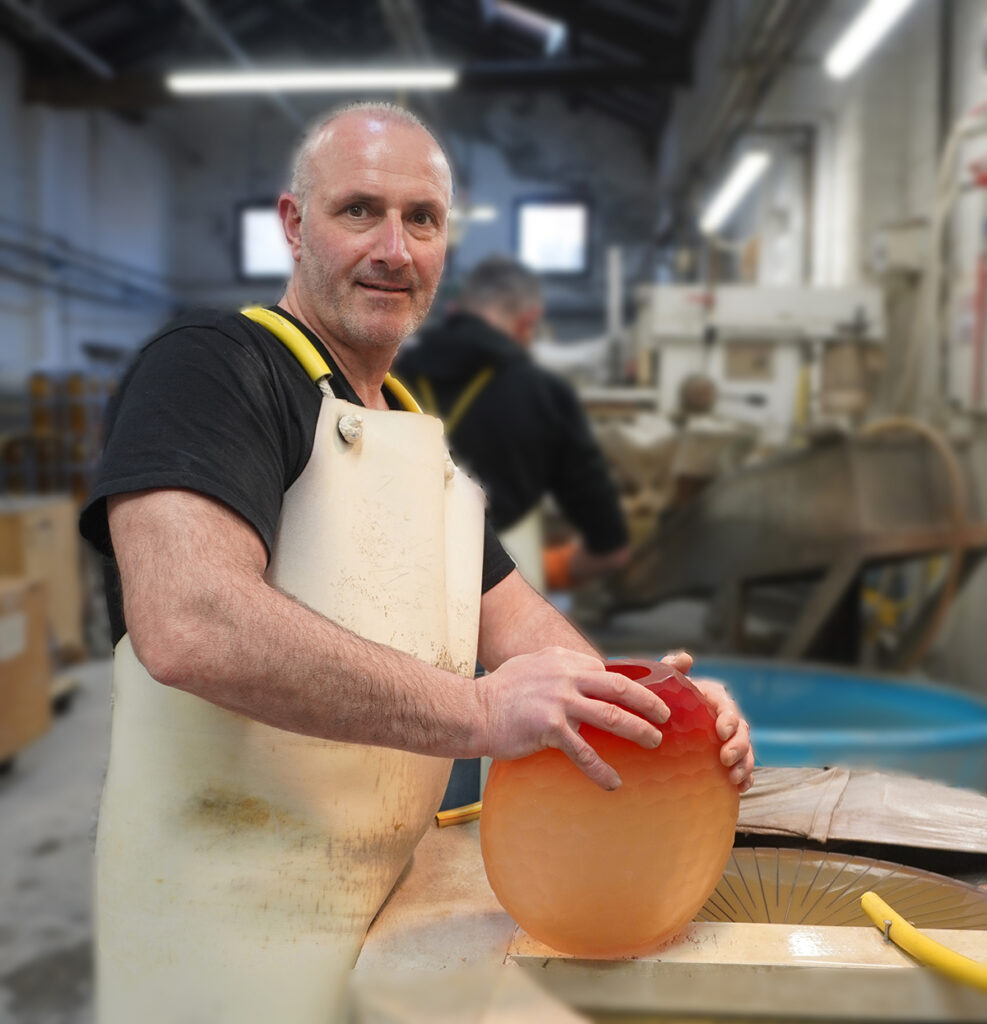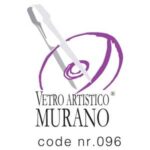An interview with Giuseppe Fort
What was your first encounter with glassblowing?
At the age of eleven, I started working in my family’s coldshop alongside my father. At sixteen, I began working for Carlo Moretti and then for others, even during my military service on the days I wasn’t in the barracks. I am the second of five siblings, and we all used to work in my father’s coldshop, but I am the only one who stayed in the Murano glass industry. I did everything, from faceting with my father to engraving at Carlo Moretti’s.
What is the difference between these two types of coldworking techniques?
With faceting, we mean Murano glass vases and ashtrays that have many “facets” (regular facets) and are, therefore, more laborious to make than other pieces since the whole surface is worked on instead of just the bottom part. When I joined Carlo Moretti at sixteen, I started by working on the “spiana” (flattening) and then, when they realized that I knew how to use the machines and work, I started doing a little bit of everything.
What is the path to becoming a coldworker, and how do you progress in the craft?
Generally, you start with suro, the glass polishing, and then you move on to doing “battuto” (etching). Within the etching work there are two types of grinding wheels, diamond and silicon carbide. The use of silicon carbide wheels in also called stone etching, and it was done before resin bound diamond wheels were developed. Few people still use this traditional Murano glass technique, and I started teaching it to my son who is also a coldworker to preserve this tradition.
At twenty, after finishing my military service, I opened my coldshop and employed four people. I started making unique Murano glass pieces like gondolas and etched vases that were different and unique compared to what was available in Murano at the time.
The economic downfall of Murano started around 2001 and I decided to close my business early to focus on helping my wife in her glass shop. Half of the coldshops that were open at the time have now shut down.
When did you start coldworking again?
I returned to the coldshop thanks to the owner of Formia’s glass factory who invited me to work with him. Later, in 2020, I met Roberto, who called me to complete some orders, and within a few months, I was hired full-time.
Is Wave Murano Glass different than other glassblowing workshops?
Yes, very different, because we do all kinds of traditional Murano glassblowing, from glasses to chandeliers, to art pieces, as well as experimenting on new bespoke projects with artists and designers. This makes my work always exciting and challenging and I love it!
Moreover, many people visit the Wave factory to attend curated guided tours and experiences and have the opportunity to deepen their knowledge of coldworking and the cold shop, something which is unusual compared to other factories on the island.
In general, how has the coldworking changed on the island of Murano?
Coldworking has evolved over the years, and new technologies have been introduced, such as the diamond replacing the stone wheels. This has reduced the need for maintenance and allowed for more precise and uniform results. However, the machinery used remains the same as when glassblowing was born, such as the saw, the spiana (flattening wheel), the lathes, and the belt sanders.
People don’t often think about coldworking as the hotshop often takes the main stage. In reality, it is a very difficult craft that has its own challenges. What is the secret of coldworking?
The position of the hands and body changes the grinding on the glass, as well as the point where you place your gaze, especially when using the diamond wheel that carves the object quickly and can cause disasters in an instant: the margin of error in grinding is very low. The position of the fingers matters because you can apply more pressure with one finger than with another. There are many small secrets that I have learned over time and that have been passed down to me, and others that I am still trying to learn!
What is the role of the coldworker?
The master coldworker is ultimately the one who decides the fate of the piece, he can make or (literally) break it! He works together with the glassblower to accomplish the shared vision for the piece; Some things, such as some glass gondolas that I used to make, are just a simple shape in the hotshop but just like a marble sculptor I uncover it by grinding away the excess glass. Another secret of grinding is that it takes time and therefore patience.
You mentioned the importance of patience. Are there other aspects that you think are important to become a good coldworker?
Certainly, practice is essential. You have to work hard to continuously improve your skills and be open to learning from others. Additionally, you must be very focused and present while working because even a single moment of distraction can lead to a costly mistake.
Finally, you have to love what you do. For me, grinding is more than a job; it is a passion that has led me to discover the beauty and complexity of Murano glass art.





